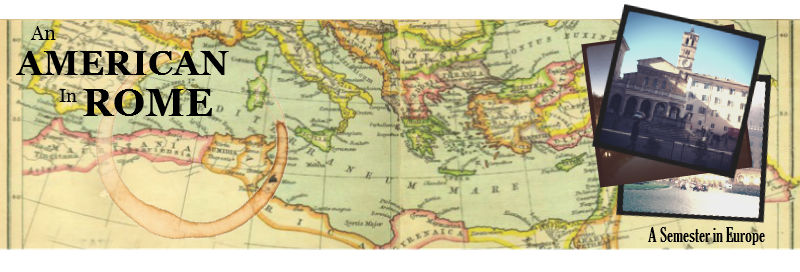First it was the first snowfall Rome had seen in two years, next it was the longest in ten, then it was the heaviest in 30 years. Friday February the 3rd was the coldest day that I've experienced thus far in (with most days averaging around 50 degrees in the winter). After my morning shower I stepped into the kitchen to see the large white snowflakes coming down in the courtyard behind out apartment.

It snowed in Rome two years ago, but it was immediately clear how unusual this snowfall was after a few hours. On the walk to school at Piazza de Orologio, traffic moved slowly, and the tram along Viale de Trastevere was delayed. As we walked down Via del Governo Vecchio towards a cafe for warmth, a beer, and a panino before class, the Romans stood out in the narrow street with their cameras, making snowballs, or just staring up at the sky in awe. While there was a brief snowfall in 2010, this was the heaviest and most consistent snowfall in over thirty years. It was freezing out and the snow had already begun to accumulate as we walked through Piazza Navona. The streets of Rome are paved with square cobbles called Sanpietrino which proved treacherous and slippers when coupled with the snow and pedestrians moved slowly down the streets to avoid slipping, but also to take in the rarity of the experience.
A city with an average winter temperature fluctuating between 40 and 60 degrees is never prepared for snow. The tables and chairs of the outdoor cafes were still set for the day as the snow piled on them, and little Fiat 500's crept on their thin tires through the slippery streets; I saw no mopeds on the streets that day. City officials seemed equally unprepared and mystified by the sudden precipitation. Instead of salt trucks and snowplows, men with buckets of salt walked into the center of intersections and tried to spread the salt around while street sweeping trucks used their spinning brushes to try to push the slush and snow off the sidewalks and streets.

The snow fell steadily through the night and the sky was clear by noon the following day, but the city was in a snow induced comma. The narrow streets of Trastevere were completely shut down and the public transit was too. Very few cars moved down the broad boulevards that cut through the center of town. Instead, the sidewalks knew no bounds as pedestrians spilled out onto the streets to look at the effects of the largest snowfall to hit Rome in their recent memory. There was an look of something extraordinary, unusual, and profound in their faces as they took in the sight of it; the whole city seemed to be paused.
It appeared that everyone had brought out their cameras, and the snowmen that dotted Piazza de Santa Maria leaned against the little cars that were snowed in for the day. Behind these cars boys poked their heads out to toss a snowball across the alley at friends or unsuspecting pedestrians, all to engrossed in the scene to care.
This rare snowfall will be memorialized in my mind not only by the newspaper photographs of snowmen by the Colosseum and nuns playing in the snow around the Vatican, but also by the feeling of trudging through the snowdrifts on these narrow Mediterranean streets, and the looks on the Roman's faces which told me how special the moment we experienced was.



.jpg)

